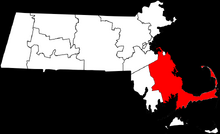"By the sword we seek peace, but peace only under liberty" | |||||||
| Capital | Plymouth | ||||||
| Largest city | Brockton | ||||||
| Language official |
English (Plymouth Standard) | ||||||
| others | Irish, Scottish Gaelic, French | ||||||
| Government | Constitutional-Parliamental Democracy | ||||||
| President | Mark Stankiewicz | ||||||
| Vice President | Melissa Arrighi | ||||||
| Area | 4,300 sq mi km² | ||||||
| Population | 150,000 | ||||||
| Established | 1997 | ||||||
| Currency | Plymouth Pound, Cel | ||||||
The Commonwealth of Plymouth is a city-state in what was formerly the Commonwealth of Massachusetts. It takes its name from the Plymouth Colony, one of the first colonies in North America. It borders the Outer Lands to the south, currently disputing jurisdiction of the Cape Cod region which is claimed by the Association of the Outer Lands.
History
Pre-Doomsday
Plymouth was one of the most historical spots in all of North America. Not only was it the second English settlement in the Original 13 Colonies, but the beliefs it was founded on would later become part of the framework of the Constitution of the United States. The Plymouth Colony, which was eventually joined the Massachusetts Bay Colony, lasted nearly 70 years.
In the 20th century, Plymouth's population began to double within 20 years. Although this was cut short by Doomsday, the population has slowly begun to increase again.
Doomsday
On September 25, 1983, residents of Plymouth were shook to hear of incoming ICBMs coming toward the US from the USSR. Assuming the worst to come to the big cities, the best the town and county governments could do was get to shelter and ride out the expected fallout. Across the mostly level horizons, they could see mushroom clouds in Providence and Boston. But the low yield blast over Otis Air Force Base near Barnstable caused shock waves and some thermal blast in surrounding villages. The attack on the Boston Metropolitan Area deeply affected the northern parts of Plymouth County. The Town of Plymouth soon received hundreds of refugees coming from Boston and Providence. Plymouth was blanketed in fallout, killing nearly 1,000 people, though most of the population had managed to avoid succumbing radiation contamination. Nearby county governments collapsed, leaving Plymouth to establish itself in a hard new world.
Post-Doomsday
While the situation had always remained somewhat stable in the area, the disorganization of the surviving towns and cities was a huge issue. By the spring of 1984, after a harsh winter without power, the county government attempted to establish some kind of emergency government over the surrounding area. Sending watercraft across the bay, they found that Cape Cod had already aligned itself with the "Outer Lands" which had been established in December, 1983. Plymouth County eventually grew into a mecca for those fleeing the rest of Massachusetts, which for the most part was in chaos.
By May, 1984, the government of Plymouth County created a provisional government known as the "Provisional government of Massachusetts at Plymouth" with hopes of eventually restoring the whole state to its historical boundaries within whatever remained of the United States. They were hopeful of gaining the lost peninsula of Cape Cod but negotiations broke down by summer's end. Over the next decade, expeditions inland found little in the way of civilization. The former Rhode Island was a wasteland, and the towns of eastern Massachusetts had long since been abandoned. The former government of Vermont had been apparently replaced by those wishing for a single state in New England to go by the name of the Republic of Vermont. Parts of western Massachusetts, in fact had been taken over by that government.
Speech of 1986
Along with much of the North, Plymouth had a harsh period in November of 1986, when snowfall was too much to grow/plant crops. Many people were beginning to commit suicide at the fact that there would be no more food to last the winter. However, the Council, in a last ditch attempt to save the morale of the Plymouthers, planned something extra special for Thanksgiving Day. The Mayor of Plymouth gave a speech on Thanksgiving Day about how their ancestors once arrived in this same town, and faced hardships like they did today. The modern day Plymouthers could not give up on the town they have inhabited since hundreds of years ago. They must keep their home alive. This speech boosted the morale of the citizens and the desire to "survive".
It was around this time that they came into contact with the Outer Lands.
Foundation of the Commonwealth
Finally, in 1997, contact was made with Canada which informed Plymouth of the dissolution of the United States of America two years before. So, in December of 1998, a constitutional convention was held to the establish the Commonwealth of Plymouth. That document laid out the historical boundaries of the original Plymouth Colony as its own and laid claim to the constitutional boundaries of the state known historically as the Commonwealth of Massachusetts. Having seen the devastation first hand, the framers had also claimed much of the disputed areas from colonial times (which eventually become other states), but have since dropped those claims due to international relations.
Present Day
By the 21st century, Plymouth had contact with Canada and the Celtic Alliance. With this international help Plymouth has grown into a relatively successful nation complete with a major port at Plymouth, the original port city of New England.
Having received so many refugees from the devastated nuclear wasteland that had been Massachusetts, with the dehibilitating factors of radiation sickness, lead to some tough decisions. More and more, the stricken victims had begged to be "put out of [their] misery" which led to the legalization of euthanization in 2007.
In March of 2010, Plymouth officially requested for the return of Vermont's Massachusetts lands to Plymouth control. Chances are, however, that they will remain in Vermont's grasp, and many in Plymouth fear that Vermont's expansionism will eventually consume all of New England, including Plymouth.
Plymouth's 10th Annual Thanksgiving Festival began on November 26th, and this year turnout is expected to be twice as the other years.
Economy
The economy of Plymouth primarily relies on the sea. Timber and Agriculture remain dominant in the more rural areas of the interior of Plymouth, but whaling and fishing are the livelihood of the average man. Agricultural products of note include livestock, and fruits, tree nuts, and berries. As power lines have been restored, the restored Nuclear plant has begun supplying energy to several other countries, which is a huge source of income. Dependence on imports for many foods, though, has meant that food shortages continue to occur.
In recent years Plymouth has enjoyed more success as a mercantile nation, as it is the docking point for foreign (especially Celtic) merchandise coming into the region. Likewise, many of the goods coming out of the Northeast that are worthy enough to be shipped out leave through Plymouth's docks.
Culture
Plymouth has a Colonial background, and while survivalism is the culture of the era the citizens of Plymouth have not forgotten their background. Thanksgiving is the most important holiday of the town, due to the Holiday having its roots in Plymouth.
Energy
With the Pilgrim Nuclear Generating Station surviving in Plymouth, it is able to supply over 600,000 homes with electricity. It currently sells its surplus to the Outer Lands and Vermont, with plans of an underwater cable to supply power to the Maritime coastal states, including Aroostook.
The station was nonfunctional from 1983 to 1999, when the Celtic Alliance helped repair it. But even with improved relations within the community of nations, the plant's days are limited. An aged plant, needing extensive maintenance (including hard to obtain materials), is scheduled to be closed by 2015. Plans are, however, to eventually replace the power plant with a "tidal generators" out toward Cape Cod. Engineers from the Celtic Alliance assure authorities that these stations will not interfere with the fishing industry, for they are to be within a quarter mile of the shore at high tide and not in the open bay where most of the fish are found.
Military
As reports of incoming ballistic missiles were heard, the military all over America had evacuated military bases first, assuming the worst. Small bases like Camp Edwards, near Barnstable, were easy to evacuate, as was the adjacent Otis Air National Guard Base. These forces had saved several planes and transport vehicles as they spread north into Plymouth county. Otis was practically destroyed by nearby 4 kt bomb that was a ground burst, cutting them off from Barnstable and the whole Cape as well as practically destr. But once the fallout had dispersed, the underground bunkers near Otis and Camp Edwards yielded the essential materials to train soldiers and can maintain its current troop number of 8000 and reservists at 4,000. As a result, these surviving troops became the military of Plymouth. It is not mandatory to join the military but all who wish to go to college must be a member of the Plymouth Home Guard, or must be an ex-member of the Plymouth Army. Directly after Doomsday, the troops stationed there were deployed to impose martial law.

Plymouth troops preparing to scout out the Greater Boston Area
The military is made up of the:
Plymouth Air Corps - numbering 500 soldiers. The Air Corps is primarily used to scout the lawless lands around Plymouth. Currently, it is commanded by General Stephen A. Flaherty.
Army of Plymouth - numbering 5000 soldiers. - In case of a war, the Army would be used to launch ground assaults. Currently, it is commanded by General James E. English, who is also the overall military commander.
Plymouth Navy - numbering 2000 soldiers - Plymouth's Navy is rather adept considering the town borders the sea. The navy is in charge of safeguarding ships entering and leaving the harbor. It is commanded by Commander Walter Wrye IV.
Home Guard of Plymouth - 2000 soldiers - In case of emergencies, the Home Guard will be used to defend the Homeland.
Emergency Reaction Militia - 2000 soldiers - If the Home Guard fails, the ERM would be used as a back-up plan to make a last stand in a last ditch attempt to defend their sovereignty. Currently underfunded, mainly armed with hunting rifles and pistols.
Government
The Commonwealth of Plymouth is a constitutional democracy. It is led by a President, who is in charge of the executive branch, and a Parliament, which is in charge of the judicial and legislative branches. The president is elected every 4 years no term limitations. In addition, the president may be given emergency powers for up to 8 years. Members of Parliament may be elected every 2 to 6 years.
International Relations
Plymouth has applied to join the League of Nations. It is also a member of the United Communities.
Without a doubt, Plymouth's most steadfast ally is the Celtic Alliance, which has invested heavily in the town, which is the docking point for many merchants who seek to trade with the North Americans. This relationship is so close that the Cel is accepted as currency in many taverns and markets.
They also have relations with North Penn, State College, Lake Placid, Reading, and Delmarva. They do not get along with Vermont and with the Outer Lands due to disputes over Western Massachusetts and Cape Cod respectively, although relations with the Outer Lands have improved significantly. They also have a rival to the north that also claims to be a successor to Massachusetts. It has also applied to join the Atlantic Defense Community, being the first American successor state to do so.


